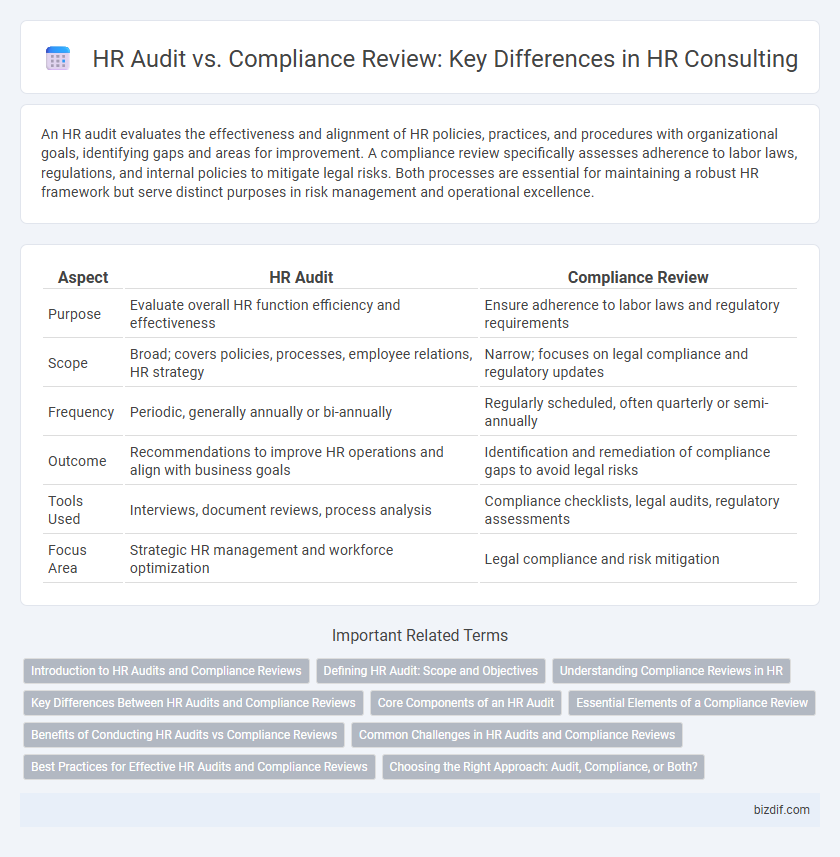An HR audit evaluates the effectiveness and alignment of HR policies, practices, and procedures with organizational goals, identifying gaps and areas for improvement. A compliance review specifically assesses adherence to labor laws, regulations, and internal policies to mitigate legal risks. Both processes are essential for maintaining a robust HR framework but serve distinct purposes in risk management and operational excellence.
Table of Comparison
| Aspect | HR Audit | Compliance Review |
|---|---|---|
| Purpose | Evaluate overall HR function efficiency and effectiveness | Ensure adherence to labor laws and regulatory requirements |
| Scope | Broad; covers policies, processes, employee relations, HR strategy | Narrow; focuses on legal compliance and regulatory updates |
| Frequency | Periodic, generally annually or bi-annually | Regularly scheduled, often quarterly or semi-annually |
| Outcome | Recommendations to improve HR operations and align with business goals | Identification and remediation of compliance gaps to avoid legal risks |
| Tools Used | Interviews, document reviews, process analysis | Compliance checklists, legal audits, regulatory assessments |
| Focus Area | Strategic HR management and workforce optimization | Legal compliance and risk mitigation |
Introduction to HR Audits and Compliance Reviews
HR audits systematically evaluate an organization's human resources policies, procedures, and practices to ensure alignment with strategic goals and legal requirements. Compliance reviews focus specifically on adherence to labor laws, regulations, and internal policies to minimize legal risks and penalties. Both processes provide critical insights into workforce management and regulatory obligations, enhancing organizational effectiveness and risk mitigation in HR functions.
Defining HR Audit: Scope and Objectives
HR audit encompasses a comprehensive evaluation of an organization's human resources policies, practices, and procedures to assess overall effectiveness and alignment with business objectives. Its scope includes talent acquisition, employee development, performance management, compensation, and employee relations, aimed at identifying strengths and areas for improvement. The primary objectives focus on mitigating risks, ensuring regulatory compliance, enhancing workforce productivity, and supporting strategic HR initiatives.
Understanding Compliance Reviews in HR
Compliance reviews in HR systematically assess adherence to labor laws, company policies, and industry regulations to mitigate legal risks and ensure ethical standards. These reviews identify gaps in employee documentation, wage and hour practices, workplace safety measures, and recordkeeping accuracy. Ensuring ongoing compliance supports organizational integrity, reduces the risk of costly penalties, and promotes a trustworthy work environment.
Key Differences Between HR Audits and Compliance Reviews
HR audits provide a comprehensive evaluation of an organization's human resources policies, practices, and functions to identify potential risks and opportunities for improvement, while compliance reviews focus specifically on adherence to legal regulations and labor laws. HR audits assess broader aspects such as employee relations, performance management, and talent development, whereas compliance reviews concentrate on verifying documentation and processes to ensure regulatory compliance. The scope of HR audits is strategic and operational, contrasting with the legally driven, checklist-oriented nature of compliance reviews.
Core Components of an HR Audit
An HR audit systematically evaluates core components such as recruitment processes, employee records, performance management, compensation practices, and workplace policies to ensure alignment with legal standards and organizational goals. It provides a comprehensive analysis of compliance with labor laws, risk management, and internal controls, identifying gaps and areas for improvement. Unlike a compliance review, which primarily focuses on regulatory adherence, an HR audit includes strategic elements like talent management effectiveness and employee engagement metrics.
Essential Elements of a Compliance Review
A compliance review in HR focuses on essential elements such as adherence to labor laws, regulatory requirements, and internal policies, ensuring all documents and practices meet legal standards. It involves evaluating employee records, wage and hour laws, benefits administration, workplace safety, and anti-discrimination policies to mitigate legal risks. Unlike an HR audit that provides a broader organizational assessment, a compliance review specifically targets regulatory conformity to protect the company from penalties and lawsuits.
Benefits of Conducting HR Audits vs Compliance Reviews
Conducting HR audits provides a comprehensive evaluation of an organization's HR policies, practices, and systems, identifying inefficiencies and areas for strategic improvement beyond regulatory adherence. HR audits uncover potential risks and gaps in workforce management, enhancing overall organizational performance and employee satisfaction. Compliance reviews focus primarily on meeting legal requirements, while HR audits deliver broader insights that help optimize human capital and reduce costly liabilities.
Common Challenges in HR Audits and Compliance Reviews
Common challenges in HR audits include identifying gaps in policy adherence, inconsistencies in employee records, and overlooked legal requirements. Compliance reviews often struggle with keeping up-to-date with evolving labor laws and ensuring all documentation meets regulatory standards. Both processes require detailed data analysis and continuous monitoring to mitigate risks of non-compliance and potential legal penalties.
Best Practices for Effective HR Audits and Compliance Reviews
Effective HR audits and compliance reviews require systematic evaluation of policies, procedures, and practices against current labor laws and industry standards. Utilizing data-driven assessments and regular employee feedback ensures identification of gaps, risks, and opportunities for improvement. Implementing continuous monitoring mechanisms and detailed documentation enhances organizational compliance and supports proactive risk management in human resources.
Choosing the Right Approach: Audit, Compliance, or Both?
Selecting the appropriate HR approach depends on organizational needs: an HR audit provides a comprehensive evaluation of policies, practices, and workforce effectiveness, while a compliance review focuses strictly on adherence to labor laws and regulations. Combining both ensures thorough risk management by identifying operational gaps and legal vulnerabilities, promoting optimal HR function and regulatory compliance. Businesses aiming for strategic HR excellence and minimized legal exposure benefit most from integrating detailed audits with focused compliance assessments.
HR audit vs compliance review Infographic

 bizdif.com
bizdif.com